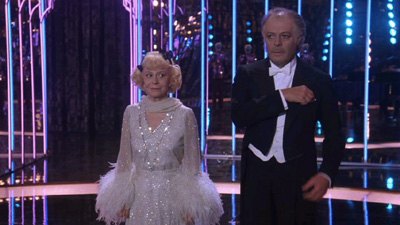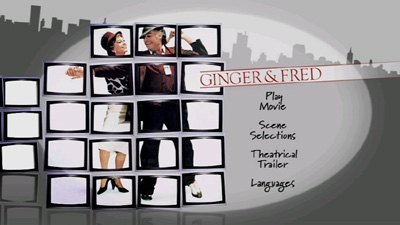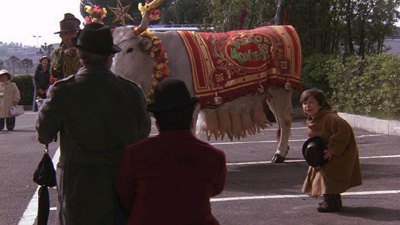| Reviews & Columns |
|
Reviews DVD TV on DVD Blu-ray 4K UHD International DVDs In Theaters Reviews by Studio Video Games Features Collector Series DVDs Easter Egg Database Interviews DVD Talk Radio Feature Articles Columns Anime Talk DVD Savant Horror DVDs The M.O.D. Squad Art House HD Talk Silent DVD
|
DVD Talk Forum |
|
|
| Resources |
|
DVD Price Search Customer Service #'s RCE Info Links |
|
Columns
|
|
|
Ginger and Fred
THE MOVIE:

Federico Fellini only made two films after 1986's Ginger and Fred, and one could already see him preparing his farewell to a golden age of cinema that had already passed.
Ginger and Fred brings together the maestro's two most iconic stars, Giulietta Masina and Marcello Mastroianni, as Amelia and Pippo, a pair of hoofers who performed in the 1940s in the style of Fred Astaire and Ginger Rogers. It's been nearly forty years since they last danced together, but a special Christmas variety show is reuniting the team as part of its cavalcade of freaks and look-alikes. The other acts include a rare couple who is honestly and truly in love, an aging admiral that is said to be a hero, a Ronald Reagan impersonator that doesn't speak English, and a cow with eighteen teats. As declared by one of the members of Los Lilliputians, a troupe of dancing midgets, that's enough for each of them to feed from before going on.
The film follows the tap-dancing duo over a 24-hour period--arriving in Rome, going to the TV station, the broadcast, and departure. Amelia is nervous about seeing her former partner, though her fears that he won't perceive her as youthful and vivacious anymore are probably unnecessary. Pippo is losing his hair and may have lost a little bit of his mind, too, so he's not really one to judge. Neither of them knows exactly what they are doing there or whether they've made the right choice in agreeing to perform, but as the broadcast draws closer, so does the gap of the absent years diminish, and the two find each other again.
Fellini's Rome, once a vision of decadent cool, has now become a bit of a cultural wasteland. Trash piles up in the streets, and vagrants are on every corner. To get from their hotel to the nightclub across the street, the various performers--a Clark Gable look-alike, stand-ins for famous authors, and a scandalous transvestite (a Fellini cast to a T)--must traverse a muddy sinkhole. Wherever any of the players go, they are confronted with a television set. Whatever room they are in, the TV is always running, and always loud. When the power goes out, people aren't happy when it's restored because they can see each other again, but because the boob tube resumes. One of the oddities paraded out on the variety program is a woman who was paid to be isolated from her TV for a month, and she describes it as the most horrible time in her life. Pippo insists that when he gets on the air, he will break from the routine and inform the Italian public that they are sheep and chastise them for being slaves to the glowing box.
Given that Mastroianni was considered a long-time stand-in for Fellini, it's not a far stretch to interpret Pippo's stance as the director's own. He, too, could be fearing that his powers are fading and that he can no longer compete in this new age. For a man who made a career out of celebrating freaks and peeking behind the showbiz curtain, it seems he views TV as a gaudy end-of-the-line. His cast here, being celebrated for their near lack of talent, predicts the current crop of "reality" stars by two decades. Fellini creates them and the short TV segments playing in the background with a vicious glee, skewering the medium for its tactless use of sex and gastric delights. Even the musical score, composed by Nicolo Piovani, seems designed to be synthesized and modern in a grating fashion, sounding more like Giorgio Moroder than Nino Rota.
But then, maybe the maestro also sees a little bit of himself in the dominant media. Certainly he can't deny his own use of bright colors and sexualized images? If Ginger and Fred is an expression of anxiety, then it is also the director pulling up his pants and stepping out to prove himself. Ginger and Fred are reunited to evoke a sense of nostalgia in the viewing audience, and Fellini is doing the same, reminding us that all of this entertainment had to start somewhere, and that the people who established the tradition--himself, Masina, and Mastroianni--still have something left to offer. (Giulietta Masina, in particular, is still capable of the physical comedy that made her such a delight in La Strada.)
Ginger and Fred isn't the greatest Fellini film, to be sure. Fellini's best days really were behind him. Yet, he does what he sets out to do, making his case for the brand of solid entertainment he built his name on. Ginger and Fred ends up being intoxicating, as Fellini rushes to keep up the pace as he piles on character after character, spectacle after spectacle. There is little time to get bored, as another outrageous sight will soon present itself. It's only when we reach the final act that we pause, as Amelia and Pippo collect themselves and strut their stuff. Fellini isn't so crazy as to give them an unqualified triumph, but the bittersweet victory is far more suitable to what he's doing: proving that cinema can still entrance us the way it did all those years ago.

THE DVD
Video:
Ginger and Fred has gotten a clean, though average, transfer to DVD. There is no trace of surface dirt and the colors all look good, though unremarkable. The occasional soft edge shows up, but it quickly passes.
Sound:
The original Italian audio track is presented in mono with removable English subtitles. The subtitles seemed a little small, but they were still readable. There are noticeable spaces where some dialogue seems to be skipped over. This is normal in the crowd scenes when the Italian streams by so fast, it would be fairly difficult to read at the pace of speech, but the absence also occurs at times when just one person is talking. I suppose we're probably not missing much, but that there is something missing is fairly obvious.
Extras:
Only the theatrical trailer is included.
FINAL THOUGHTS:
Recommended. Federico Fellini made many a tribute to show business in his career, but Ginger and Fred is different in that it takes the old vaudeville tradition and ponders how it will survive in the age of television. The result moves from indictment of the modern age to a celebration of what made classic cinema so appealing. As stand-ins for Fred Astaire and Ginger Rogers, Marcello Mastroianni and Giulietta Masina show they still have it, and though it might be a piece of fluff in the director's distinguished career, it's an entertaining one.

Jamie S. Rich is a novelist and comic book writer. He is best known for his collaborations with Joelle Jones, including the hardboiled crime comic book You Have Killed Me, the challenging romance 12 Reasons Why I Love Her, and the 2007 prose novel Have You Seen the Horizon Lately?, for which Jones did the cover. All three were published by Oni Press. His most recent projects include the futuristic romance A Boy and a Girl with Natalie Nourigat; Archer Coe and the Thousand Natural Shocks, a loopy crime tale drawn by Dan Christensen; and the horror miniseries Madame Frankenstein, a collaboration with Megan Levens. Follow Rich's blog at Confessions123.com.
|
| Popular Reviews |
| Sponsored Links |
|
|
| Sponsored Links |
|
|
| Release List | Reviews | Shop | Newsletter | Forum | DVD Giveaways | Blu-Ray | Advertise |
|
Copyright 2024 DVDTalk.com All Rights Reserved. Legal Info, Privacy Policy, Terms of Use,
Manage Preferences,
Your Privacy Choices | |||||||














